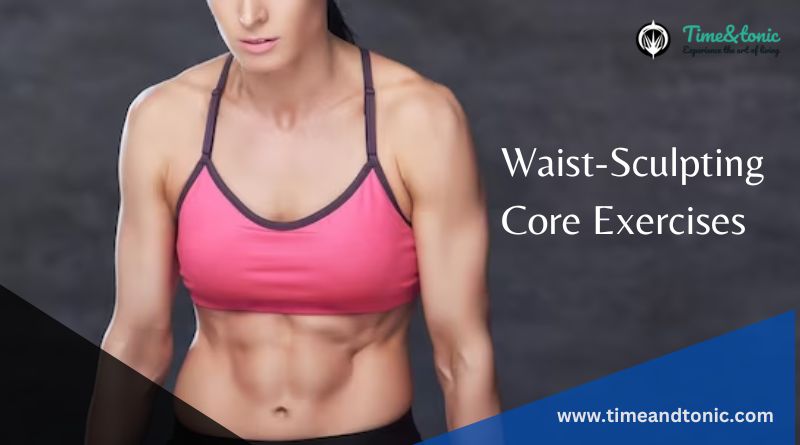The Ultimate Guide to Waist-Sculpting Core Exercises
In the pursuit of a fit and healthy physique, few achievements are as visually captivating and empowering as a sculpted waist. A well-defined waistline not only enhances your appearance but also signifies a strong core and overall bodily health. If you’re one of the many individuals on the quest for that coveted hourglass figure or simply aspire to strengthen your core for functional benefits, you’re in the right place.
Welcome to our comprehensive guide on Waist-Sculpting Core Exercises, tailored to those looking to transform their midsection in the comfort of their own routine. The road to a sculpted waist may seem daunting, but armed with the right knowledge and commitment, you can attain your fitness goals and unlock the potential of your core muscles.
In this guide, we will delve deep into the world of waist-sculpting core exercises, exploring the anatomy of the core muscles, effective workout routines, and nutritional aspects that complement your efforts. Whether you’re a beginner taking your first steps on this fitness journey or a seasoned enthusiast looking to refine your waistline, this guide is designed to provide you with the insights and tools needed to achieve the waist of your dreams. So, let’s embark on this transformative journey together and sculpt your waist to perfection!
Also Read: Healthy Low-Carb Breakfast Ideas
The Anatomy of the Core

The core, often referred to as the body’s powerhouse, is a complex system of muscles that plays a pivotal role in maintaining stability, balance, and overall bodily strength. To effectively sculpt your waist and develop a strong core, it’s essential to understand the anatomy of the core muscles that you’ll be targeting during your workouts. In this section, we’ll explore the key components of the core, shedding light on how each muscle group contributes to waist sculpting.
1. Rectus Abdominis
- Location: Running vertically along the front of your abdomen, commonly known as the “six-pack” muscles.
- Function: Responsible for flexing the spine and bringing the ribcage toward the pelvis.
- Role in Waist Sculpting: Strengthening the rectus abdominis helps create definition along the front of the waistline.
2. Obliques (Internal and External)
- Location: Found on the sides of your abdomen, with internal and external obliques positioned at different depths.
- Function: External obliques assist in rotating the trunk and bending to the side, while internal obliques aid in trunk rotation and core stability.
- Role in Waist Sculpting: Well-developed obliques contribute to a toned and cinched waist, enhancing its shape.
3. Erector Spinae
- Location: Running along the spine’s length, on either side of the vertebral column.
- Function: Responsible for extending and rotating the spine and maintaining an upright posture.
- Role in Waist Sculpting: Developing the erector spinae muscles supports a strong and balanced core, aiding in waist sculpting exercises.
Also Read: Healthy Breakfast Ideas for a Nourishing Start
Preparing for Your Waist-Sculpting Core Workout

Before diving into your waist-sculpting core workout, it’s essential to prepare your body properly. Proper preparation not only helps prevent injuries but also ensures that you get the most out of your exercises. In this section, we will discuss the key steps to prepare for your waist-sculpting core workout.
1. Warm-Up Exercises:
- Importance of Warming Up: A good warm-up is the foundation of any effective workout. It slowly increases your heart rate, increases your body temperature, and prepares your muscles for more intense activity. This reduces the risk of strains and injuries during your core workout.
- Dynamic Stretches: Dynamic stretches are ideal for warming up your core muscles. Include movements like leg swings, arm circles, russian twist, and hip circles in your warm-up routine. These stretches promote flexibility and mobility in the core area.
2. Proper Posture and Technique:
- Importance of Correct Form: Maintaining proper form during core exercises is crucial. It not only maximizes the effectiveness of your workout but also prevents injury. Focus on maintaining a neutral spine, engaging your core muscles, and using controlled, deliberate movements.
- Common Mistakes to Avoid: Be aware of common mistakes such as arching your back, straining your neck, or using momentum to perform exercises. These errors can lead to discomfort and hinder your progress.
3. Equipment and Attire:
- Depending on your chosen core exercises, you might need specific equipment like a yoga mat, stability ball, or dumbbells. Ensure that you have all the necessary equipment ready before starting your workout.
- Wear comfortable workout attire that allows for a full range of motion. Proper footwear is also essential, especially if you plan to include standing or dynamic exercises in your routine.
Also Read: Delicious Ideas for Low-Carb Diet
Waist-Sculpting Core Exercises

Now that you’re adequately prepared, it’s time to dive into a selection of effective waist-sculpting core exercises. These exercises specifically target the core muscles, helping you build strength, tone, and define your waistline. Incorporate these exercises into your routine for optimal results.
Crunches and Variations
- Traditional Crunches:
- Knees bent and feet flat on the floor, lie on your back.
- Put your hands across your chest or behind your head.
- Using your core muscles, raise your shoulders off the ground.
- Lower your upper body back down without straining your neck.
- Repeat as many times as necessary.
- Bicycle Crunches:
- Kneel down on the floor with your legs raised off the surface.
- Put your hands on the back of your head.
- While extending your right leg, bring your right elbow and left knee together.
- In a pedaling motion, switch sides while keeping your core active.
- Reverse Crunches:
- Your feet should be elevated as you lay on your back with your knees bent.
- For support, put your hands next to you or under your hips.
- Using your lower abs, raise your hips and legs off the ground.
- Without letting your legs touch the ground, bring your legs back down.
- Repeat while maintaining control.
Planks and Isometric Holds
- Standard Plank:
- Beginning with a push-up, but with your weight on your forearms and elbows, perform the exercise.
- Engage your core and keep your body in a straight line from head to heels.
- As long as you keep your posture proper, hold this position.
- Side Planks:
- With your legs extended and an elbow placed directly beneath your shoulder, lie on your side.
- With your legs extended and an elbow placed directly beneath your shoulder, lie on your side.
- Hold this position on each side to work the oblique muscles.
Also read: 10 Amazing Low-Carb Breakfast Recipes
Leg Raises and Twists
- Hanging Leg Raises:
- Hang with your legs fully extended from a pull-up bar.
- Keep your legs straight as you lift them upward.
- Gently bring them back down.
- During the entire movement, keep your core engaged.
- Russian Twists:
- Kneel down on the floor with your feet flat.
- While maintaining a straight back, lean back slightly..
- Twist your torso to the left and then to the right while holding a weight or a medicine ball.
- Engage your oblique muscles as you rotate.
Swiss Ball Exercises
- Swiss Ball Rollouts:
- Kneel on the floor with a Swiss ball in front of you.
- Your forearms should be on the ball.
- Keep your body straight and roll the ball forward while extending your arms.
- Using your core muscles, roll it back to the starting position.
- Swiss Ball Pikes:
- Assume a push-up position with your feet resting on a Swiss ball.
- Bring your feet up to your chest while engaging your core and lifting your hips upward.
- Return to the starting position while maintaining straight legs.
Also read: 10 Best Breakfasts For Weight Loss
Creating a Waist-Sculpting Core Workout Routine
Designing an effective waist-sculpting core workout routine requires careful planning and consideration. Here, we’ll guide you through the process of creating a balanced and progressive workout plan to help you achieve your waist-sculpting goals.
1. Setting Realistic Goals:
- Begin by defining your specific goals. Do you want to strengthen your core, tone your waistline, or achieve a more defined look? Setting clear and achievable objectives will keep you motivated and on track.
2. Designing Your Routine:
- Frequency and Duration: Aim for at least 3 to 4 core workouts per week. Each session should last between 20 to 30 minutes, depending on your fitness level and available time.
- Exercise Selection: Include a variety of exercises to target different core muscles. Mix and match exercises from the previous section to create a well-rounded routine.
- Progression: Increase the intensity of your workouts over time to gradually challenge your core muscles and see progress.
3. Sample Waist-Sculpting Core Workout Plan:
- Warm-Up: Start with 5-10 minutes of dynamic stretches and light cardio to increase blood flow and prepare your muscles for exercise.
- Exercise Set 1 (2-3 sets):
- Crunches (15-20 reps)
- Russian Twists (10-12 reps per side)
- Plank (Hold for 30-45 seconds)
- Exercise Set 2 (2-3 sets):
- Leg Raises (12-15 reps)
- Side Planks (Hold for 20-30 seconds per side)
- Swiss Ball Rollouts (10-12 reps)
- Exercise Set 3 (2-3 sets):
- Bicycle Crunches (12-15 reps per side)
- Hanging Leg Raises (8-10 reps)
- Swiss Ball Pikes (10-12 reps)
- Cool Down: Finish your workout with 5-10 minutes of static stretching to improve flexibility and aid in recovery.
4. Progress Tracking:
- Maintain a workout journal to track your progress. Record the number of reps, sets, and any changes in exercise difficulty.
- Regularly measure your waist circumference to monitor changes in your waistline.
5. Adjustments:
- As you become more comfortable with your routine, consider adding more challenging exercises or increasing the intensity. You can also decrease rest periods between sets to keep your heart rate up.
6. Rest and Recovery:
- Adequate rest is crucial for muscle recovery and growth. Ensure you have rest days in your weekly routine to allow your core muscles to recover.
- Listen to your body and avoid overtraining, which can lead to injuries and burnout.
Also Read: 10 Worst Starbucks Drinks
Conclusion
In conclusion, sculpting a waist that you’re proud of is not just about aesthetics; it’s about building a strong, resilient core that supports your overall health and fitness. By embracing the waist-sculpting core exercises and principles outlined in this guide, you’ve taken the first steps toward achieving your fitness goals. Remember, consistency and patience are your allies on this journey. With determination and the knowledge you’ve gained, your dream waist is well within reach. Keep pushing forward, and success will be yours.
Also read: Best Free Weight Exercises for a Powerful Physique
FAQ
No, spot reduction is a myth. Core exercises can strengthen and tone your core muscles, but they won’t specifically reduce fat from the waist. A balanced diet and overall calorie expenditure are essential for losing fat in any area of your body.
Aim for at least 3 to 4 core workouts per week. Consistency is important to seeing results.
Yes, many core exercises are beginner-friendly. Start with basic exercises and progress to more challenging ones as you build strength and confidence. Always prioritize proper form to prevent injuries.




